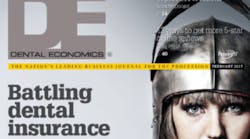Dental water line infection control: A work in progress
Although effective, user-friendly choices are available to meet the challenge of infection control for dental water lines, it is ultimately up to individual dentists and dental personnel to choose and use them correctly.
The first report describing high concentrations of bacteria in dental handpiece water lines was published in the British Medical Journal by Blake in 1963. (1) Subsequent studies have built on this pioneer investigation by (a) looking at mechanisms of microbial biofilm formation, (b) demonstrating that the long, narrow plastic lines used to deliver water and air during patient treatment provide both optimal growth environments for microbial colonization and a potential health hazard by releasing contaminated water into patients' mouths and the air, (c) identifying multiple classes of microorganisms in dental water samples, (d) developing effective approaches to treat dental unit water lines (DUWL) and reduce bacterial colonization, and (e) developing analytical systems to monitor water quality.
Many of the scientific and technological advances relating to microbial contamination of DUWL came about following reports by the Centers for Disease Control and Prevention (CDC) describing outbreaks in communities and hospitals caused by waterborne pathogens. These included bacteria such as Legionella pneumophila, Escherichia coli, Pseudomonas sp., and a highly resistant protozoan, Cryptosporidium parvum. With specific regard to dentistry, potential human pathogens, including Pseudomonas, Klebsiella, Legionella, and nontuberculous Mycobacterium species, have been isolated from dental water supplies. These and most other microbes detected in dental water systems originate from the public water supply and do not usually present a high disease risk for healthy persons. However, these organisms could potentially cause infection and clinical illness in immune-compromised individuals. The challenge presented by contaminated DUWL has unfortunately shifted in recent years from the "potential" infection category to "documented" cross-infection and illness. Since 2012 there have been three reported instances of dental patients contracting potentially life-threatening infections after receiving treatment with heavily colonized water in practices.
Professional concerns about the potential for illness were recognized long before 2012. Both the ADA (1995) (2) and CDC have suggested goals for improving dental water quality. The comprehensive CDC Guidelines for Infection Control in Dental Healthcare Settings, 2003 (3) updated the agency's 1993 recommendations (4) that called for flushing dental water lines at the beginning of the day and between patients, and the use of sterile water or saline for irrigation of surgical sites where bone is exposed. The following statement was included to provide guidance for acceptable bacterial concentrations in water going into patients' mouths: "Use water that meets EPA regulatory standards for drinking water (i.e., <500 CFU/mL heterotrophic water bacteria) for routine dental treatment output water."
Both the ADA and CDC recommendations challenged the dental profession and manufacturers to address this problem. As a result, a range of engineering and work practice controls are available to improve water quality, as well as a variety of commercial products designed to control microbial accumulations. While each strategy and product has both advantages and disadvantages, comparing them with suggested features of an "ideal" water line treatment could be helpful in selecting one that best fits a practice's needs (Table 1).
Table 1: Desirable properties for dental water treatment strategies
1. Rapidly microbiocidal |
2. Exhibits broad-spectrum antimicrobial activity against bacteria, fungi, protozoa |
3. Ability to disrupt/disperse accumulated biofilms |
4. Nontoxic to equipment or patients |
5. Nonpyrogenic |
6. Nonallergenic |
7. Noncorrosive to metals |
8. Does not damage rubber or synthetic materials |
9. Does not interfere with performance of any dental restorative or therapeutic agents |
10. Environmentally friendly |
Fortunately, there are multiple choices to consider. No matter the option, remember that water quality goals can only be reached by application of basic infection control principles and compliance with product instructions. The straightforward clean it first principle is essential for the initial removal of microorganisms and other accumulated extracellular material in water lines before subsequent treatment to maintain low microbial levels. Treating cleaned water lines to minimize subsequent microbial colonization may involve a different product and/or require another series of steps. For example, combination system products are available that contain separate water line cleaning agents and maintenance chemicals. They are effective, but only when used appropriately. Compliance with manufacturers' step-by-step procedures is important.
Although effective, user-friendly choices are available to meet the challenge of dental water asepsis, it is ultimately up to the individual dentists and dental personnel to choose and use them correctly. The fundamental infection control principles still apply as you consider, evaluate, and use DUWL options.
John A. Molinari, PhD, is director of infection control for the Dental Advisor. Previously, he was professor and chairman of the Department of Biomedical Sciences at the University of Detroit Mercy School of Dentistry. Contact him at [email protected].
References
1. Blake GC. The incidence and control of bacterial infection in dental spray reservoirs. Br Dent J. 1963;19:413-416.
2. Statement on dental unit water lines. American Dental Association website. ada.org/en/member-center/oral-health-topics/dental-unit-waterlines. Published 1995. Updated August 19, 2016. Accessed January 13, 2017.
3. Guidelines for infection control in dental health-care settings, 2003. Centers for Disease Control and Prevention. https://www.cdc.gov/mmwr/preview/mmwrhtml/rr5217a1.htm. MMWR 2003;52(RR-17):1-61. Published December 19, 2003. Accessed January 13, 2017.
4. Centers for Disease Control and Prevention. Recommended infection-control practices for dentistry, 1993. https://www.cdc.gov/mmwr/preview/mmwrhtml/00021095.htm. MMWR 1993;42(RR-8). Published May 28, 1993. Accessed January 13, 2017.
About the Author
John A. Molinari, PhD
John A. Molinari, PhD, is director of infection control for the Dental Advisor. Previously, he was professor and chairman of the Department of Biomedical Sciences at the University of Detroit Mercy School of Dentistry. Contact him at [email protected].
Bio updated June 1, 2017
